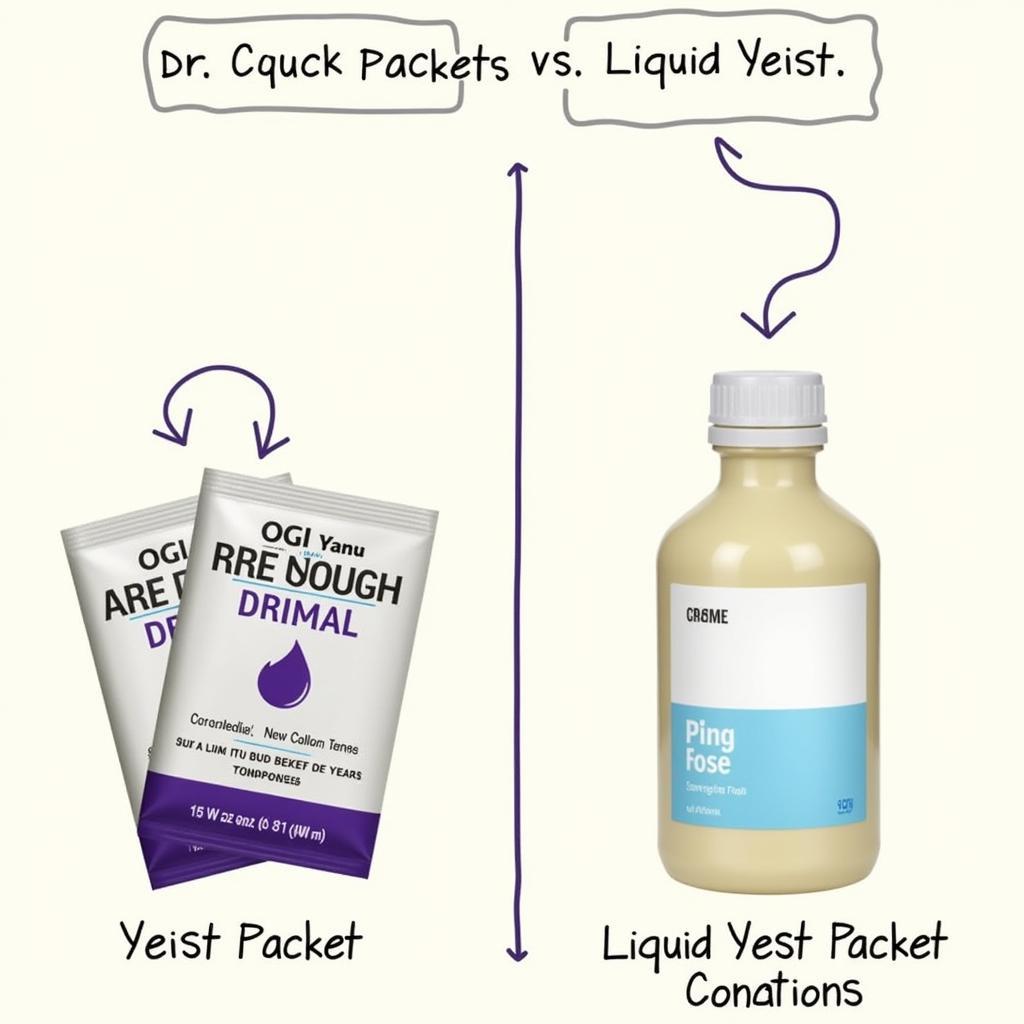Dry yeast and liquid yeast are the two main types of yeast used in brewing, each with its own set of advantages and disadvantages. Choosing the right one can significantly impact the flavor and aroma of your beer. This article delves into the key differences between dry yeast and liquid yeast to help you make an informed decision for your next brew.
Understanding Yeast in Brewing
Before diving into the specifics of dry yeast and liquid yeast, it’s crucial to grasp the fundamental role yeast plays in brewing beer. Yeast, a single-celled fungus, is the magical ingredient responsible for fermentation. During fermentation, yeast consumes the sugars extracted from malted grains and converts them into alcohol and carbon dioxide. This process is what transforms wort (the sugary liquid produced from mashing grains) into beer.
 The Difference Between Dry Beer Yeast and Liquid Beer Yeast
The Difference Between Dry Beer Yeast and Liquid Beer Yeast
Different yeast strains possess unique characteristics, influencing the final product’s flavor profile, aroma, and even clarity. Some yeast strains produce fruity esters, while others yield spicy phenols. Understanding the impact of different yeast varieties is crucial for crafting a beer that aligns with your desired taste.
What is Dry Yeast?
Dry yeast is a type of brewer’s yeast that has been dehydrated and packaged for extended shelf life. It comes in small sachets or packets and is a popular choice for homebrewers due to its convenience, affordability, and long shelf life.
Advantages of Dry Yeast
- Convenience: Dry yeast is incredibly easy to use. It doesn’t require refrigeration and can be stored at room temperature for months or even years, making it ideal for brewers who brew infrequently.
- Affordability: Dry yeast is generally less expensive than liquid yeast, making it a cost-effective option, especially for large batches.
- Widely Available: Dry yeast is readily available at most homebrew shops and online retailers, offering a vast selection of strains.
Disadvantages of Dry Yeast
- Limited Strain Variety: While dry yeast offers a decent variety, the selection pales in comparison to liquid yeast.
- Potential for Less Complex Flavors: Some brewers find that beers fermented with dry yeast may lack the nuanced flavors and aromas achieved with liquid yeast.
- Rehydration Required: While not overly complicated, dry yeast typically needs rehydration before pitching, adding an extra step to the brewing process.
What is Liquid Yeast?
Liquid yeast, as the name suggests, is yeast suspended in a liquid solution. It typically comes in vials or tubes and offers a broader range of strains compared to dry yeast.
Advantages of Liquid Yeast
- Extensive Strain Variety: Liquid yeast opens up a world of possibilities for brewers, with an extensive selection of strains available, catering to diverse beer styles and flavor profiles.
- Enhanced Flavor Complexity: Many brewers believe that liquid yeast produces beers with richer, more complex flavors and aromas compared to dry yeast.
- Higher Cell Count: Liquid yeast typically contains a higher concentration of viable yeast cells, leading to faster and more efficient fermentation.
Disadvantages of Liquid Yeast
- Shorter Shelf Life: Liquid yeast has a significantly shorter shelf life than dry yeast and requires refrigeration.
- Higher Cost: Liquid yeast is generally more expensive than dry yeast.
- Increased Risk of Contamination: Improper handling of liquid yeast can increase the risk of contamination, potentially ruining your entire batch.
Making the Right Choice: Dry Yeast or Liquid Yeast?
 Choosing the Right Yeast for Brewing
Choosing the Right Yeast for Brewing
The choice between dry yeast and liquid yeast ultimately boils down to your individual brewing preferences and goals.
- For Beginners: Dry yeast is often recommended for novice brewers due to its ease of use, affordability, and forgiveness.
- For Experimentation: Liquid yeast is ideal for adventurous brewers seeking to explore a wide range of flavors and aromas.
- For Specific Styles: Certain beer styles, like Belgian ales or German lagers, often benefit from the unique characteristics of specific liquid yeast strains.
Tips for Success
Regardless of your choice, following these tips can help ensure a successful fermentation:
- Proper Storage: Store both dry and liquid yeast according to the manufacturer’s instructions to maintain viability.
- Sanitation: Maintain meticulous sanitation practices throughout the brewing process to prevent contamination.
- Pitching Rate: Use the appropriate pitching rate for your chosen yeast and beer style.
- Temperature Control: Maintain consistent fermentation temperatures within the recommended range for your yeast strain.
Conclusion
Both dry yeast and liquid yeast have their place in the world of brewing. Understanding the pros and cons of each, along with your brewing goals, will help you select the right yeast to create your perfect beer. Cheers to your next brewing adventure!
FAQ
1. Can I use dry yeast after the expiration date?
While dry yeast has a long shelf life, it’s best to use it within the recommended timeframe for optimal performance. Yeast activity declines over time, potentially leading to sluggish fermentation or off-flavors.
2. Do I need to make a starter for liquid yeast?
While not always necessary, making a yeast starter is generally recommended for liquid yeast, especially for high-gravity beers or when using older yeast. A starter helps increase the yeast cell count, ensuring a healthy and vigorous fermentation.
3. How long can I store liquid yeast in the refrigerator?
Liquid yeast should be stored in the refrigerator (34-40°F or 1-4°C) and is best used within 4-6 months of the packaging date for optimal viability.
4. Can I reuse yeast from a previous batch?
Yes, yeast can be harvested and reused from a previous batch, a process known as yeast harvesting. However, it requires proper sanitation and handling to prevent contamination.
5. Where can I buy dry and liquid yeast?
Dry and liquid yeast can be purchased from most homebrew supply shops and online retailers.
Still have questions?
Contact our team at Phone Number: 0372999888, Email: [email protected], or visit us at 236 Cầu Giấy, Hanoi. We have a 24/7 customer support team ready to assist you.